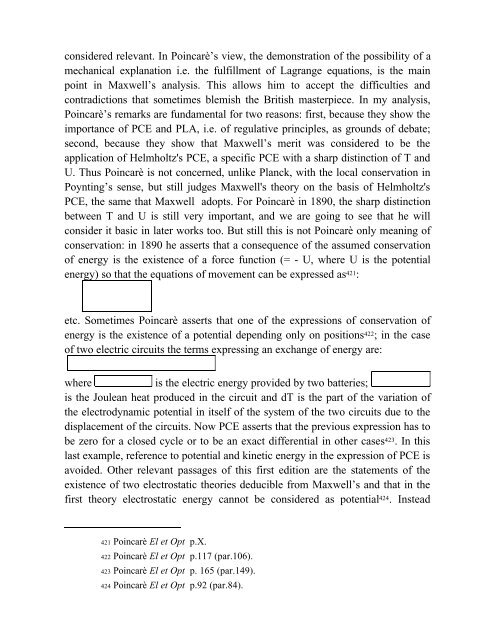Conservation and Innovation : Helmholtz's Struggle with Energy ...
Conservation and Innovation : Helmholtz's Struggle with Energy ...
Conservation and Innovation : Helmholtz's Struggle with Energy ...
You also want an ePaper? Increase the reach of your titles
YUMPU automatically turns print PDFs into web optimized ePapers that Google loves.
considered relevant. In Poincarè’s view, the demonstration of the possibility of a<br />
mechanical explanation i.e. the fulfillment of Lagrange equations, is the main<br />
point in Maxwell’s analysis. This allows him to accept the difficulties <strong>and</strong><br />
contradictions that sometimes blemish the British masterpiece. In my analysis,<br />
Poincarè’s remarks are fundamental for two reasons: first, because they show the<br />
importance of PCE <strong>and</strong> PLA, i.e. of regulative principles, as grounds of debate;<br />
second, because they show that Maxwell’s merit was considered to be the<br />
application of <strong>Helmholtz's</strong> PCE, a specific PCE <strong>with</strong> a sharp distinction of T <strong>and</strong><br />
U. Thus Poincarè is not concerned, unlike Planck, <strong>with</strong> the local conservation in<br />
Poynting’s sense, but still judges Maxwell's theory on the basis of <strong>Helmholtz's</strong><br />
PCE, the same that Maxwell adopts. For Poincarè in 1890, the sharp distinction<br />
between T <strong>and</strong> U is still very important, <strong>and</strong> we are going to see that he will<br />
consider it basic in later works too. But still this is not Poincarè only meaning of<br />
conservation: in 1890 he asserts that a consequence of the assumed conservation<br />
of energy is the existence of a force function (= - U, where U is the potential<br />
energy) so that the equations of movement can be expressed as 421:<br />
etc. Sometimes Poincarè asserts that one of the expressions of conservation of<br />
energy is the existence of a potential depending only on positions 422; in the case<br />
of two electric circuits the terms expressing an exchange of energy are:<br />
where is the electric energy provided by two batteries;<br />
is the Joulean heat produced in the circuit <strong>and</strong> dT is the part of the variation of<br />
the electrodynamic potential in itself of the system of the two circuits due to the<br />
displacement of the circuits. Now PCE asserts that the previous expression has to<br />
be zero for a closed cycle or to be an exact differential in other cases 423. In this<br />
last example, reference to potential <strong>and</strong> kinetic energy in the expression of PCE is<br />
avoided. Other relevant passages of this first edition are the statements of the<br />
existence of two electrostatic theories deducible from Maxwell’s <strong>and</strong> that in the<br />
first theory electrostatic energy cannot be considered as potential 424. Instead<br />
421 Poincarè El et Opt p.X.<br />
422 Poincarè El et Opt p.117 (par.106).<br />
423 Poincarè El et Opt p. 165 (par.149).<br />
424 Poincarè El et Opt p.92 (par.84).
















